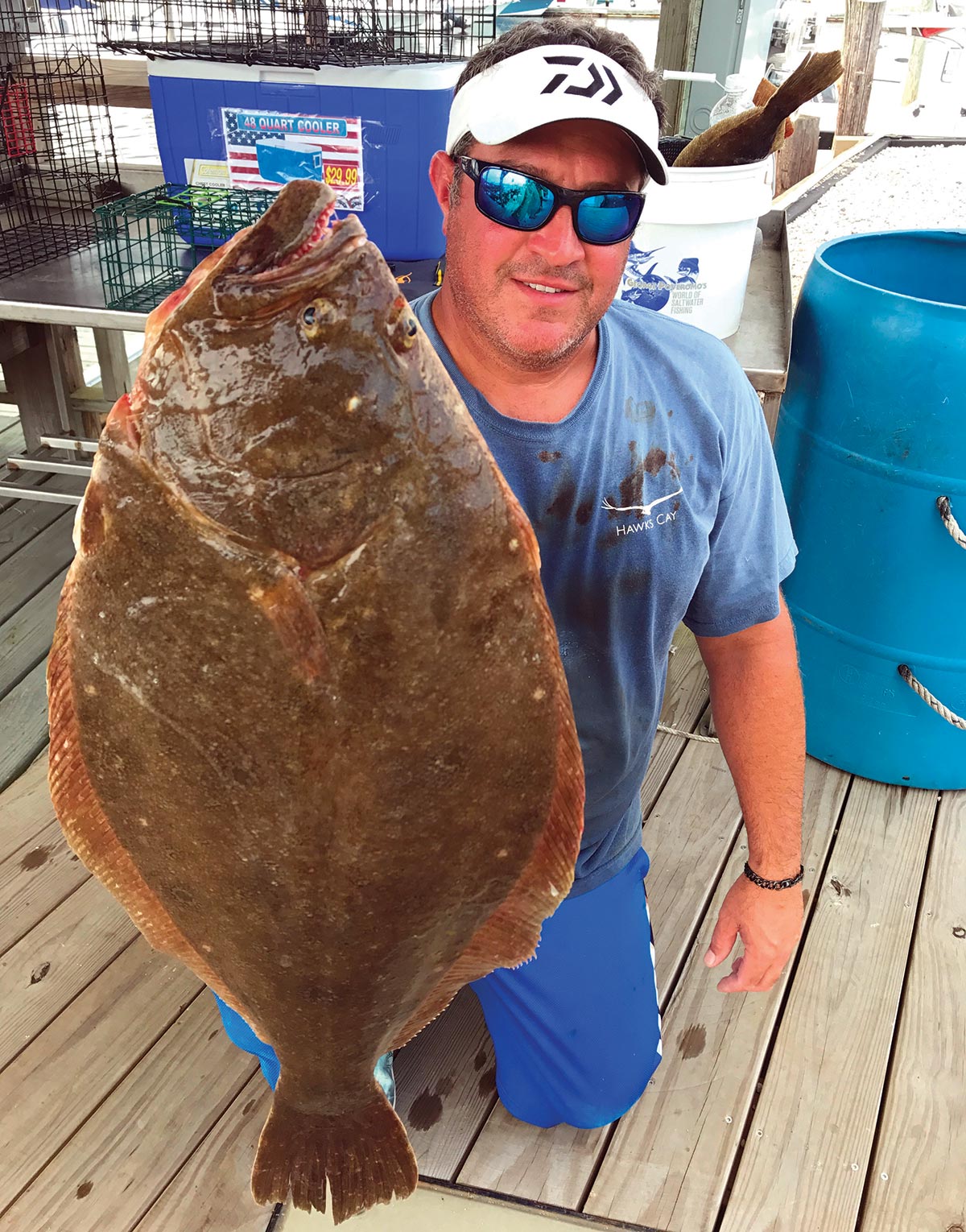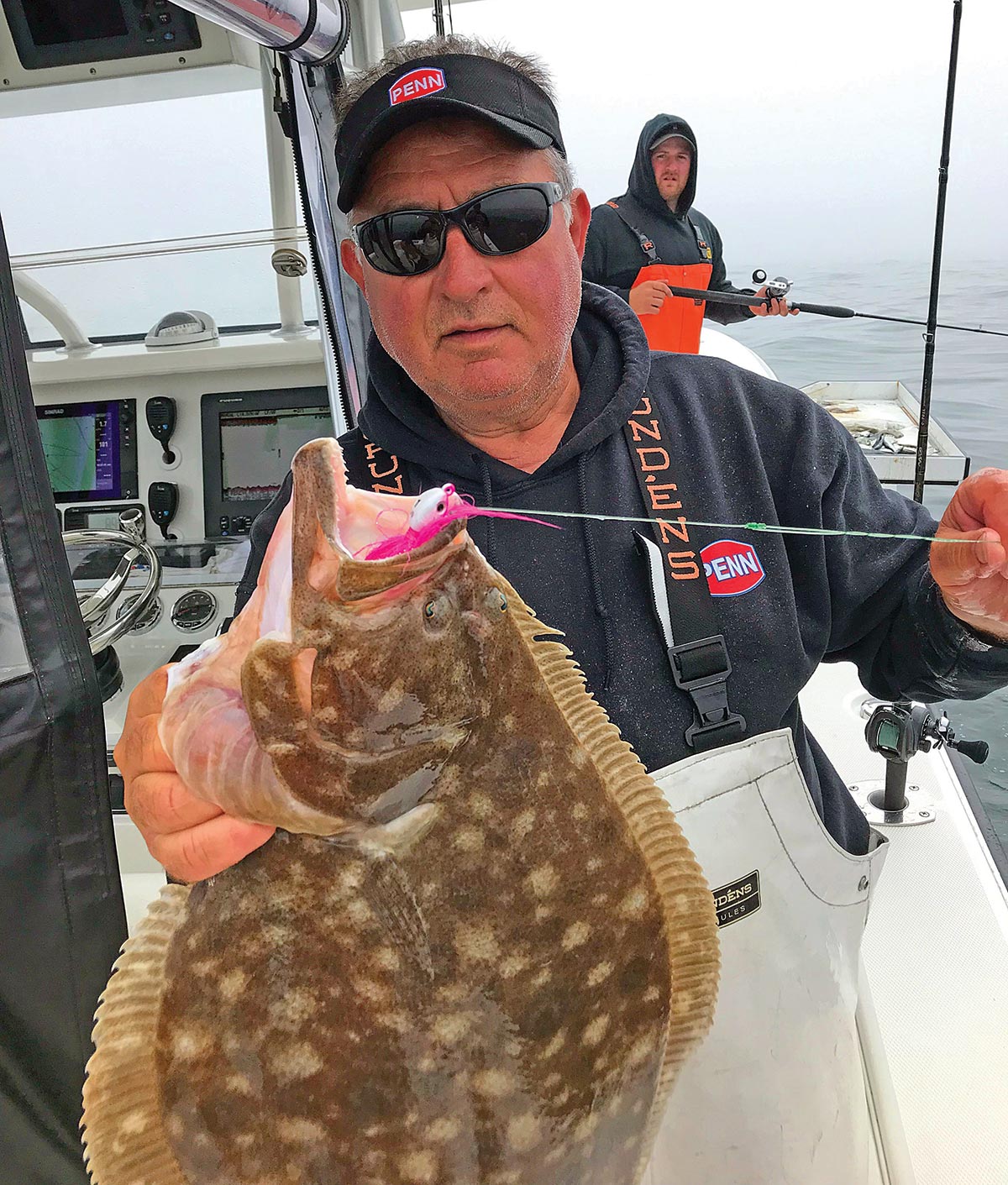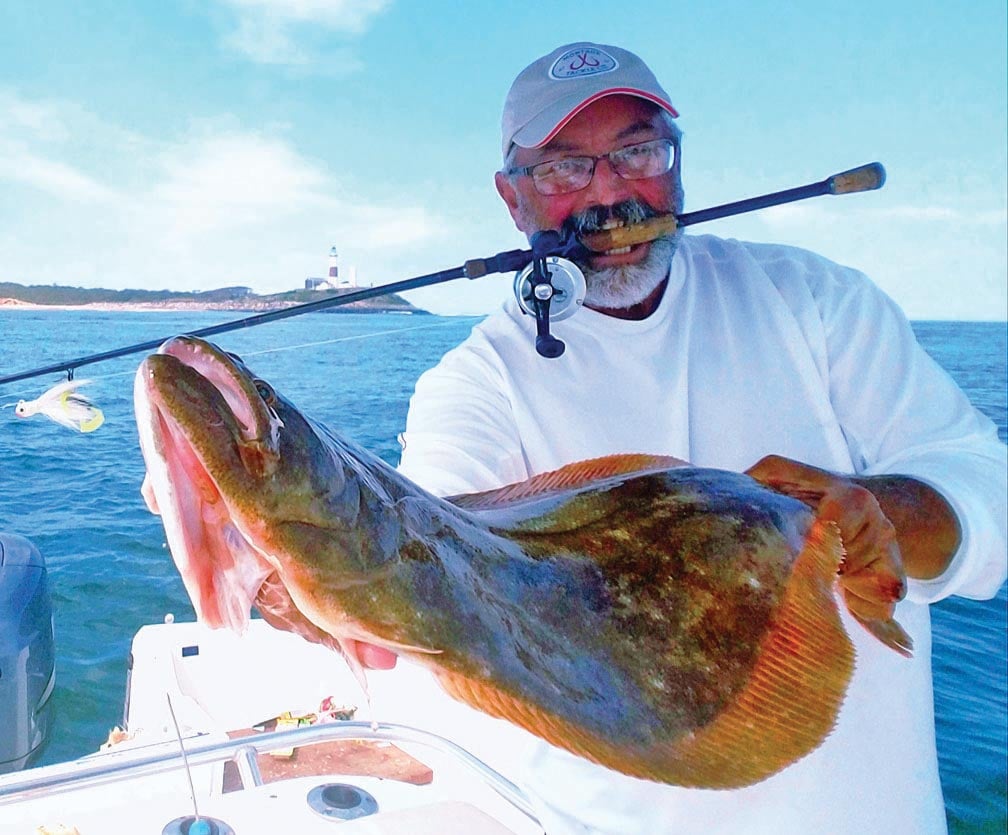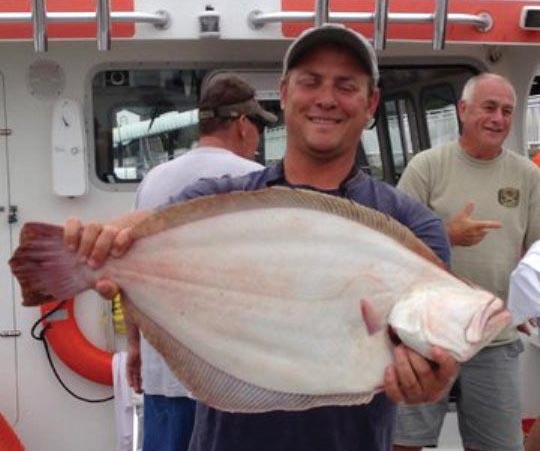Tired of culling through dozens of shorts to find a keeper? Put these tactics to work to improve the quality of your fluking.
With another fluke season upon us, many anglers find themselves culling through many undersized fish in search of a few fish to take home for the dinner table. As a result, an increasing number of folks are expanding their search beyond traditional places that have produced in the past, like inlets, estuaries and back bays. Instead they are heading out towards deeper waters. This article is dedicated to targeting fluke in 60- to 120-foot depths, so buckle up and let’s get down to the bottom of it all.
If you think that fishing in 15- to 30-foot waters chugging through an inlet at different stages of the incoming or outgoing tide was a challenge, wait until you get out to deeper waters. Keeping your baits or lures in the target zone, while dealing with a combination of wind, current, tide and wave action, will really challenge your angling and boating skills.

Tips From the Experts
Sometimes the best way to learn how to do something is to talk to the charter boat captains and sharpies who do it more often than you. I spoke with five of the sharpest knives in the drawer to get some additional perspectives for this piece, so let’s hear what the “reel” experts have to say before I share some of my advice.

Capt. Joey Leggio of Chasin’ Tails TV and Fish_Long_Island.com skippers a relatively petite 20-foot Maritime Skiff, but is one of the top fluke anglers on Long Island’s west end. He prefers conventional outfits for his deep water fluke fishing, which is focused in 60- to 90-foot depths, working reefs, rock piles and the edges of numerous inshore wrecks that dot the New York Bight area. Capt. Joey’s personal fluke gear consists of 6.5-foot and 7-foot Daiwa Proteus trigger grip rods in either light or medium action, combined with a Daiwa Lexa 300 baitcasting reel spooled with 30-pound braid. To this he attaches a 40-pound section of Quattro Plus 40-pound leader that he takes off a large bulk spool. The larger spools don’t have that curly “set” you get from smaller spools. Capt. Joey prefers 30-pound braid over lighter lines since he is fishing a lot of structure consisting of concrete and rebar, steel wrecks or scrap. When asked Capt. Leggio what his favorite deepwater fluke rig was he responded, “I like a single Spro Prime bucktail jig from 1.5 to 4 ounces, depending on the depth, current and sea conditions. To this, I’ll usually attach a 5- or 6-inch Gulp Curly Tail Grub, with the preferred colors being pink shine, chartreuse and nuclear chicken. When the grub’s tail is bitten off, I’ll recharge it in the Gulp juice and then attach a Fat Cow strip to add that fluttering attraction that big fluke find irresistible. Some of my other preferred rigs include a high/low rig using a chrome cannon ball as the sinker, using smaller Gamakatsu bait holder hooks and tipping these with Gulp minnows in the same colors mentioned above. My all-time favorite doormat rig is to catch small 3- to 6-inch cunners (bergalls), put them in the livewell and then drop them down on the same structure to start my fluke fishing. I’ll run a circle hook up through the lower jaw of the cunner and out its nose and get right on the edge of the structure, drop it down and then let the wind and current drift me away. I’ll dead-stick this rig in a gunwale rodholder while working the other rods and this has often proved to be the best fish-catcher.”

Capt. Demetrios “Jimmy the Greek” Koutalakis runs On Time Charters out of Yarmouth, MA and is an expert fishing the waters near the coastal islands and Nantucket Shoals. He runs a 34-foot SeaVee center console powered by twin Merc 350 Verados and has the speed and range to fish some really productive, distant deepwater fluke areas. He too prefers conventional baitcasting tackle for his fishing and uses Abu-Garcia Revo and Beast reels, spooled with either 20- or 30-pound Berkley X9 braid attached to 7-foot Black Hole Challenger rods in light and medium action. These are burley enough to stand up to the 10- to 14-ounce sinkers that are sometimes required to work the running tides where the big fluke reside. His preferred bait is a Gulp 6-inch grub, especially when dogfish are present. Nuclear chicken, pink shine and white are the go-to colors, depending on what type of bait is in the area. He will also employ 5- to 6-inch Gulp Swimming Mullets in the same colors. When targeting deepwater fluke, Capt. Jimmy is looking for hard bottom (sandy, gravel, rocky) in 60 to 100 feet of water that consists of numerous uneven humps and lumps that rise 2 to 5 feet from the bottom. He uses a 3-foot section of Berkley 40- to 50-pound mono as a shock leader and attaches this to his running line via a Spro 230-pound power swivel. When I asked him about the most ideal fishing conditions, Capt. Jimmy said, “When we are bottom fishing for fluke, the ideal drift speeds are anywhere from 0.9 to 1.7 knots. If it’s slower than that, the fluke will tend to follow the bait, but not eat it. Anything over 2 knots requires too much lead to hold bottom in deep water and there’s too much scope in the line, making it tough to feel the fluke’s sometimes less-than-aggressive pickup. When we are using bait for the flatties, we use whole spearing (Bigger is better.) and whole baby squid, but this changes day-to-day. Oftentimes I’ll have my anglers drop down different baits until we find the one that works on that day and then everyone switches over. For bucktails, I prefer the Berkley Fusion in either pink/white or green/white, up to 8 ounces if the tide and current dictate that these larger heavyweights are required.”

Capt. Savio Mizzi runs Fishooker Charters out of Montauk’s West Lake Marina, using a 23 Parker center console. He caught 10 fluke last season that ranged between 10 and 12.5 pounds and prefers working the 60- to 100-foot depths south of Montauk Point. Capt. Savio also prefers baitcasting gear like the Shimano Calcutta 300 and the Daiwa Lexa 300 models spooled with 15- and 20-pound PowerPro Maxquatro braid matched to 6- to 6.5-foot Daiwa or Shimano light to medium action rods. To this he attaches a 50-pound shot of Jinkai clear leader material that’s connected to the braid via a blood knot, claiming that Montauk fluke “are not leader shy.” According to Capt. Mizzi, “I like to fish the last hour of the tide, the slack and then the first hour of the change, either high or low. When we employ jigs, S&S bucktails in white, chartreuse and pink are my favorites, with a max weight of 2 ounces. We like to fish straight up and down whenever possible, with current flow up to 2 knots being ideal. Anything faster than that and the scope gets to be too much and fishing isn’t as productive. When using bait for deepwater doormats, I prefer a jig tipped with a 2.5- to 3-inch strip of bluefish fillet with only 1/8-inch of meat on the skin. The idea is to get this fluttering in the current and give them something to smell. The bluefish skin is tough and resists bite-offs. We also use Gulp grubs to sweeten up our bucktails. I tie my mono leaders directly to the jigs using a loop knot to ensure maximum action.”

Capt. Peter Sykes runs Parker Pete Charters out of Belmar, NJ. He specializes in targeting deep water structure with bucktails and favors as light a bucktail as required to hold bottom. Ball style jig heads tipped with a 6-inch Berkley Gulp Grub in pink shine or glow white are at the top of his list, believing these colors best approximate squid, a favorite of fluke, especially big fluke. He likes to run a baitholder hook off a dropper loop about two feet above the bucktail and will bait it with a 5-inch Gulp Swimming Mullet. Keeping the rig in constant motion is the key to drawing strikes from aggressive fluke, according to Capt. Pete. He also keeps his rigs free of any hardware – no snaps and no swivels which can get caught in wrecks, rocks or other structure he target for big fluke. He spools up with braid and uses a 30-pound fluorocarbon leader attached to his bucktail with a surgeon’s loop.
Capt. Pete has conducted a number of Fisherman sponsored seminars covering bucktailing for fluke at winter fishing and outdoor shows, and also hosts bucktail seminars aboard his 35-foot Donnell charter boat.

Capt. Ray “RB” Bartlett works Long Island’s South Shore waters from Jones Beach to Montauk and trailers his 23 Parker CC to the hottest fluke action wherever it might be. He has caught a number of deepwater doormats to 14-plus pounds. For tackle, Capt. Ray prefers a Daiwa Saltiga star drag conventional reel spooled with 20-pound PowerPro Maxcuatro line, attached to a 6.5-foot trigger grip Black Hole Charter Series rod that has a fast, sensitive tip with some backbone when it’s time to set the hook. When asked about preferred fluke rigs, Capt. Ray mentioned, “I have been using the M3 blade rigs with great success. These have a colored metal forward section and I rig them with a squid skirt followed by a pair of Octopus style J-hooks. I will attach the first hook into a bait like a whole squid, mackerel fillet or bluefish fillet. The second hook is free-swinging, so as not to restrict the enticing fluttering action of the bait. The blade is attached to the running line and attaches on either end with a quick-detach clip. I’ll use a 5-foot section of 30-pound fluorocarbon leader and fish in currents up to 1.9 knots, which prevents the blades from spinning. When the current is running faster than that, I’ll use my engine and hit reverse on occasion to slow the boat down to the ideal drifting speed.”
Drify Speed

As detailed by these sharpies, the ideal drift speeds for deepwater fluke are in the 0.5- to 2-knot range. There are times when you might have to bump your boat in and out of gear to produce a drift, or use reverse gear to slow it down. Increasing numbers of saltwater anglers are employing GPS powered electric trolling motors to set up and maintain the ideal drifting conditions. This can be a real difference-maker when you are attempting to set up the perfect drifting speed and extend that throughout the tide.
My go-to deepwater fluke rig is a Spro Prime bucktail from 1.5 to 8 ounces, tipped with Gulp, pork rind (if you can find any) or a Fat Cow strip, with a 1/2-ounce Spro bucktail running off a dropper loop set about 18 inches above the big jig. I attach the bucktail via a quick-connect stainless steel snap, which allows me to easily change colors and sizes as needed. At times, I will add a free-swinging single assist hook at the tail end of my bucktail to combat short strikers. I use a 3- to 4-inch Gulp swimming mullet on the smaller teaser and a 5- or 6-inch grub or mullet on the lower jig. My preferred bucktail colors are pink, glow and chartreuse, with the Gulps in either nuclear chicken or chartreuse.

I also favor conventional outfits for deepwater drops, since I fish with my reel in free spool with constant thumb pressure to make frequent adjustments to keep my offerings in the feeding zone. When a fluke strikes aggressively (and I’m not dropping back), my thumb is already on the spool to set the hook and I simply turn the handle on my Penn 955/975 International baitcasters to engage the gear. I employ green 20-pound Western Filament TUF-Line Domin8 braid on the 955 outfit and 30-pound on the larger 975. At the business end, I add a 5-foot length of 40-pound Quattro Plus or Berkley ProSpec as my shock leader. When using baits like a whole baby squid, XL squid strips or trimmed mackerel/bluefish/fluke belly fillets, drop-backs after the pickup are typically in order, depending on whether I am using a single or double hook stinger rig.
Deepwater fluking doesn’t always entail fishing five or more miles out in the ocean. There are many near shore areas with depths ranging from 60 to 120 feet where a friendly shoreline can buffer the wind, or don’t require traversing a potentially rough inlet. There is also an abundance of structure dotting the coast from New Jersey to Massachusetts anywhere from 1 to 4 miles offshore where so many of the tactics, gear and techniques extolled here can be put into play just a short run from your home port.




